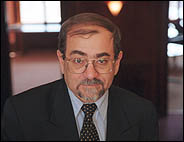Wagdi Habashi
| Wagdi Habashi moves quickly.
 PHOTO: OWEN EGAN
PHOTO: OWEN EGAN
| |
In 1977, aircraft engine builder Pratt & Whitney handed Habashi a 12-week contract to test his simulation skills on solving design problems.
The young aeronautics engineer completed the task in 12 days, cementing a relationship with the company that has now lasted for more than two decades. The firm handed Habashi and his team its first technology achievement prize in 1998. Just this month, the company named him a Pratt Whitney research fellow.
In 1990, Habashi and Pratt & Whitney entered an international contest to see who could solve a complex problem the fastest on a Cray supercomputer. Habashi's team took top spot. Runners-up included NASA.
Habashi displayed his penchant for acting swiftly when he decided to join McGill.
An admirer of McGill's new vice-principal (academic) Luc Vinet — "he's a mover and a shaker and a miracle-maker," Habashi says — he approached Vinet to see if the two of them might work together on an application to the Canadian Foundation for Innovation.
"He laughed when I called," relates Habashi. McGill was just then planning for a major CFI grant application, one that would dovetail nicely with Habashi's area of expertise.
Dean of Engineering John Gruzleski, Vice-Principal (Information Systems and Technology) Bruce Pennycook, Vice-Principal (Research) Pierre Bélanger and mechanical engineering chair S.J. Price joined the talks. After a couple of conversations, Habashi wasn't just part of the CFI plan, he was thinking in terms of moving his lab from Concordia to McGill.
The acquisition of Habashi is a coup. He is a past winner of the Natural Sciences and Engineering Research Council's Steacie Fellowship, awarded to researchers who garner international attention for their work early in their careers. He also played a leading role in establishing the Centre for Research in Computational Applications (CERCA) in 1992. Quebec Science listed Habashi's work in 1998 in its annual roundup of the province's top 10 scientific discoveries.
Habashi says the move to McGill is a homecoming of sorts. He earned both his bachelor's — finishing first in his graduating class — and master's degrees from McGill.
His area of expertise is computational fluid dynamics. CFD experts use sophisticated computer modelling techniques to calculate the flow of fluids. It's an especially important field for the design of aircraft and jet engines, explains Habashi.
Aircraft builders want to optimize the performance of their airplanes — they seek out designs that will generate the best results in terms of lift, drag and fuel consumption.
"If we're able to simulate that on a computer before the planes or engines are built, we can account for the problems that might come up and solve them then and there," Habashi says. He's currently using his simulation skills to study ways of addressing the potentially dangerous problem of ice forming on airplane wings during flights.
"We're looking into what happens when an airplane enters an icing cloud and supercooled droplets start to accrete ice on wings. Where will it hit the wings? What shape is the ice when it begins to form? How can we get rid of it?"
As for that CFI grant, Habashi is now project leader for an ambitious $23-million application that involves physicists, engineers, meteorologists and medical scientists from McGill, Laval and Univérsite du Québec à Montréal.
If successful, the partners would obtain what would be one of the most powerful supercomputers in the country.
Habashi would use it to further his own aerospace research and spies possible collaborations with physics professor Martin Grant and electrical and computer engineering professor Frank Ferrie. "There is a lot of depth at McGill."
He's in France this week. As soon as he's back, Habashi and his research team begin the task of relocating into their new digs at McGill in earnest. "I'll be surrounded by boxes," groans Habashi. Even for a man who bested NASA, moving day is one challenge that, like most Montrealers, Habashi faces with gritted teeth.

